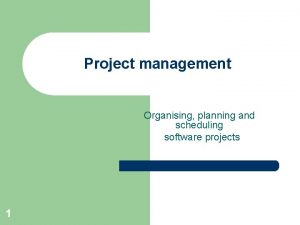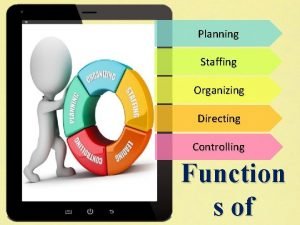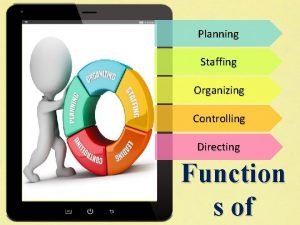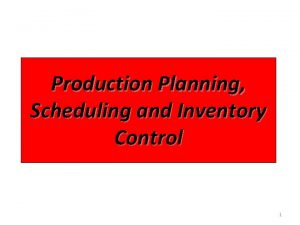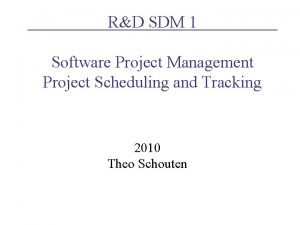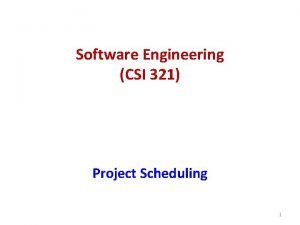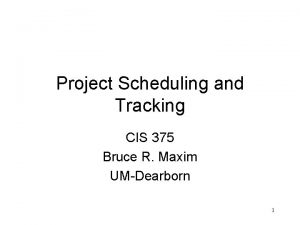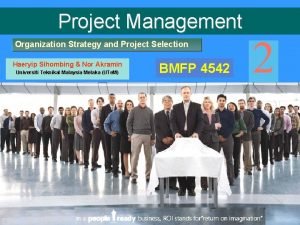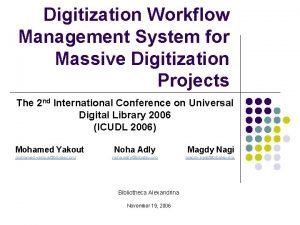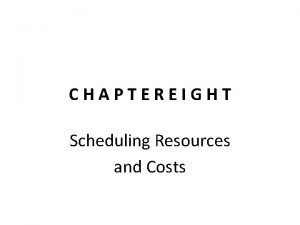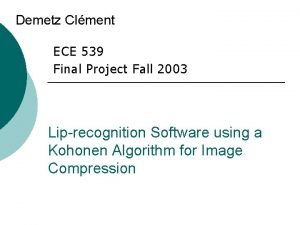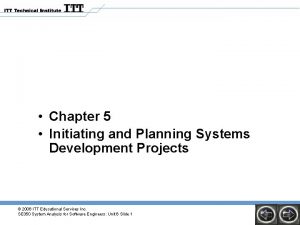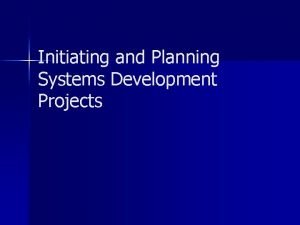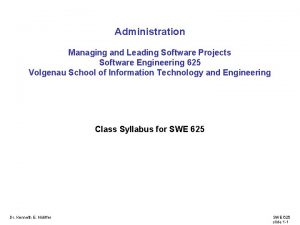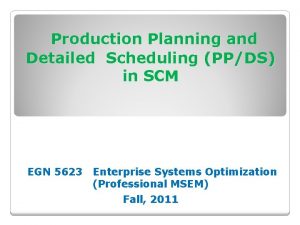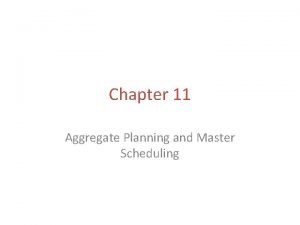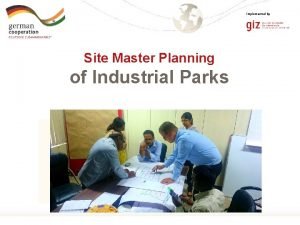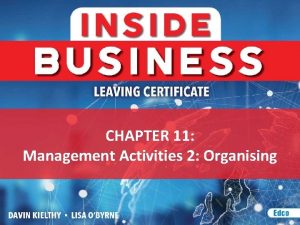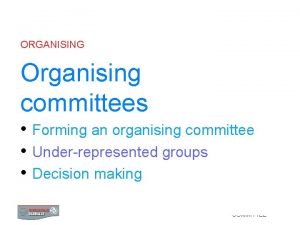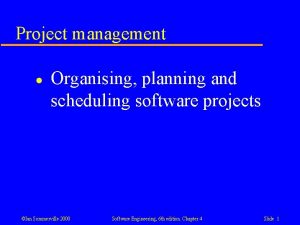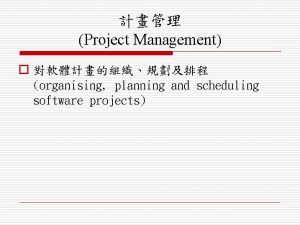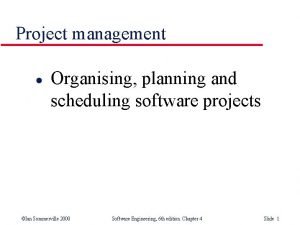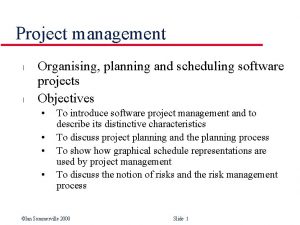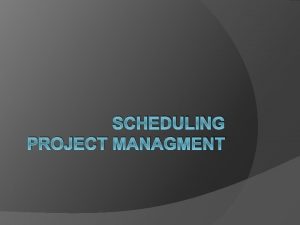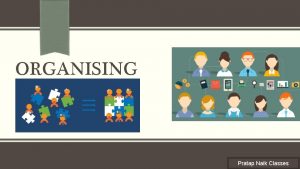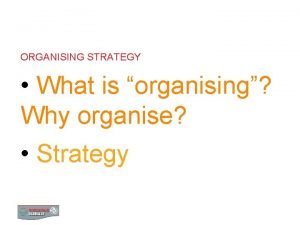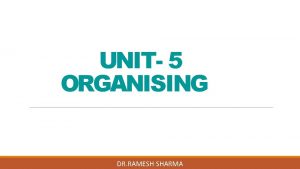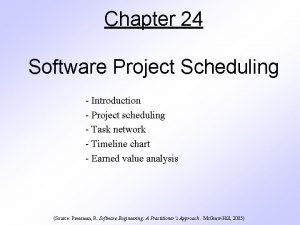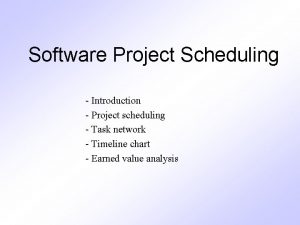Project management Organising planning and scheduling software projects































- Slides: 31

Project management Organising, planning and scheduling software projects 1

Software project management l l 2 Concerned with activities involved in ensuring that software is delivered on time and on schedule and in accordance with the requirements of the organisations developing and procuring the software Project management is needed because software development is always subject to budget and schedule constraints that are set by the organisation developing the software

Software management distinctions l l l 3 The product is intangible The product is uniquely flexible Software engineering is not recognized as an engineering discipline with the sane status as mechanical, electrical engineering, etc. The software development process is not standardised Many software projects are 'one-off' projects

Management activities l l l 4 Proposal writing Project planning and scheduling Project costing Project monitoring and reviews Personnel selection and evaluation Report writing and presentations

Management commonalities l l l 5 These activities are not peculiar to software management Many techniques of engineering project management are equally applicable to software project management Technically complex engineering systems tend to suffer from the same problems as software systems

Project staffing l May not be possible to appoint the ideal people to work on a project – – – l 6 Project budget may not allow for the use of highly-paid staff Staff with the appropriate experience may not be available An organisation may wish to develop employee skills on a software project Managers have to work within these constraints especially when (as is currently the case) there is an international shortage of skilled IT staff

Project planning l l l 7 Probably the most time-consuming project management activity Continuous activity from initial concept through to system delivery. Plans must be regularly revised as new information becomes available Various different types of plan may be developed to support the main software project plan that is concerned with schedule and budget

Types of project plan 8

Project plan structure l l l l 9 Introduction Project organisation Risk analysis Hardware and software resource requirements Work breakdown Project schedule Monitoring and reporting mechanisms

Activity organization l l 10 Activities in a project should be organised to produce tangible outputs for management to judge progress Milestones are the end-point of a process activity Deliverables are project results delivered to customers The waterfall process allows for the straightforward definition of progress milestones

Milestones in the RE process 11

Project scheduling l l 12 Split project into tasks and estimate time and resources required to complete each task Organize tasks concurrently to make optimal use of workforce Minimize task dependencies to avoid delays caused by one task waiting for another to complete Dependent on project managers intuition and experience

The project scheduling process 13

Scheduling problems l l 14 Estimating the difficulty of problems and hence the cost of developing a solution is hard Productivity is not proportional to the number of people working on a task Adding people to a late project makes it later because of communication overheads The unexpected always happens. Always allow contingency in planning (Plan for what to do if particular event happened or does not happen)

Bar charts and activity networks l l 15 Graphical notations used to illustrate the project schedule Show project breakdown into tasks. Tasks should not be too small. They should take about a week or two Activity charts show task dependencies and the critical path Bar charts show schedule against calendar time

Task durations and dependencies 16

Activity network 17

Activity timeline 18

Staff allocation 19

Risk management l l Risk management is concerned with identifying risks and drawing up plans to minimise their effect on a project. A risk is a probability that some adverse circumstance will occur. – – – 20 Project risks affect schedule or resources Product risks affect the quality or performance of the software being developed Business risks affect the organisation developing or procuring the software

Software Risk 21

The risk management process l Risk identification – l Risk analysis – l Draw up plans to avoid or minimise the effects of the risk Risk monitoring – 22 Assess the likelihood and consequences of these risks Risk planning – l Identify project, product and business risks Monitor the risks throughout the project

The risk management process 23

Risk identification l l l 24 Technology risks People risks Organisational risks Requirements risks Estimation risks

Risk and Risk Types 25

Risk analysis l l l 26 Assess probability and seriousness of each risk Probability may be very low, moderate, high or very high Risk effects might be catastrophic, serious, tolerable or insignificant

Risk Analysis 27

Risk planning l l Consider each risk and develop a strategy to manage that risk Avoidance strategies – l Minimisation strategies – l The impact of the risk on the project or product will be reduced Contingency plans – 28 The probability that the risk will arise is reduced If the risk arises, contingency plans are plans to deal with that risk

Risk management strategies 29

Risk monitoring l l l 30 Assess each identified risks regularly to decide whether or not it is becoming less or more probable Also assess whether the effects of the risk have changed Each key risk should be discussed at management progress meetings

Risk factors 31
 What is a project schedule
What is a project schedule Planning skills in the workplace
Planning skills in the workplace Planning directing controlling organizing
Planning directing controlling organizing Planning organizing staffing directing controlling
Planning organizing staffing directing controlling Inventory management and production planning and scheduling
Inventory management and production planning and scheduling Sdm in project management
Sdm in project management Csi 321
Csi 321 Project scheduling and tracking software quality assurance
Project scheduling and tracking software quality assurance Project portfolio matrix dimensions
Project portfolio matrix dimensions Digitization workflow
Digitization workflow Scheduling resources and costs
Scheduling resources and costs Activity identification approaches in spm
Activity identification approaches in spm Job scheduling vs process scheduling
Job scheduling vs process scheduling Difference between authority and responsibility
Difference between authority and responsibility Lambini and sons explained
Lambini and sons explained Self organising map
Self organising map Organizing seminars and conferences
Organizing seminars and conferences Modern project profiles in software project management
Modern project profiles in software project management What is strategic assessment in software project management
What is strategic assessment in software project management Improving software economics in project management
Improving software economics in project management Initiating and planning systems development projects
Initiating and planning systems development projects Crm vision statement examples
Crm vision statement examples Initiating and planning systems development projects
Initiating and planning systems development projects Traditional project management vs modern project management
Traditional project management vs modern project management Software configuration items
Software configuration items Managing and leading software projects
Managing and leading software projects Factors affecting media scheduling
Factors affecting media scheduling Detailed scheduling
Detailed scheduling Scheduling and planning
Scheduling and planning Pulsing scheduling examples
Pulsing scheduling examples Disaggregating an aggregate plan leads to a master schedule
Disaggregating an aggregate plan leads to a master schedule Site master plan example
Site master plan example
